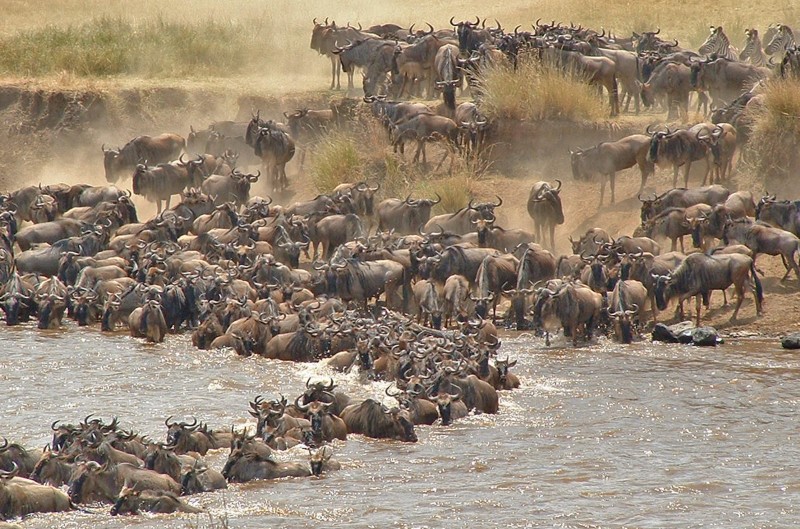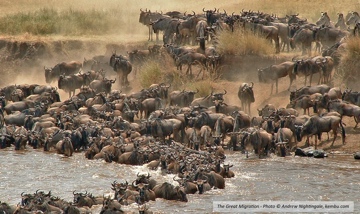My guide to the Great Migration
It's that time of year again! I can't count how many times I've seen the great migration - but every time it's different and every time it's jaw-droppingly spectacular. Read my quick guide to this wildlife phenomenon - then grab your camera and go!

WHAT
In November 2006, the newspaper USA Today and the TV show Good Morning America revealed a new list of Seven Wonders of the World, as chosen by six judges: the great migration was named one of the seven. However, contrary to what its name suggests, this isn’t a single annual event, but a constant cycle in which vast numbers of animals flow in a circuit around Kenya and Tanzania. While watching these animals trying to dodge waiting crocodiles as they plunge across the great Mara River makes for the most exciting moments of the migration, the crossings are far from being the only thrill of the season. Watching the golden savannah turn black from the sheer numbers of animals coursing across it, or spotting the animals fleeing from avaricious lions – or being seized by them – are events that give a real insight into the world of wildlife.
WHERE
The cycle flows around the Mara Serengeti Ecosystem, which is made up of the Maasai Mara in Kenya and the Serengeti in Tanzania. This season sees the animals in Kenya, making their way north through the plains of the Maasai Mara and crossing the Mara River. While even the most accomplished safari guide can’t be sure when and where they’ll cross, there are ways to place yourself in the most likely position to see this. Once you’ve found your place, the only thing to do is to sit in silence and wait. If any noise or movement spooks the animals, they’ll turn and flee, depriving you of your chance of watching that heart-stopping moment when they leap into the water – or get dragged beneath it. To find potential crossing sites, look for bends in the river, which often build up pressure in the herds causing the animals to cross. Look especially for those places where there’s not too much cover – brush or woodland – in which predators can hide, as these make the animals nervous. Although, on occasion, it has been known for herds to plunge into the river in places that can only be described as suicidal.
WHEN
While no two migration cycles are the same, there are some features of the animals’ movement that recur year after year. After the long rains of April and May, in about June, the herds start moving north into Kenya, crossing the savannah plains and rushing rivers of the Mara. During this season the wildebeest mate, and the males often spar with each other to gain dominance of the females. From about October, by which time most of the females are pregnant, the animals start moving south, heading back into the Serengeti. In January and February, the birthing starts and up to 400,000 wildebeest calves are born. A few months later, when the calves are ready to undertake the long journey, the animals start moving north again, continuing their never-ending circle around the region.
WHO
The most numerous animal to migrate is the wildebeest, or gnu, which moves in numbers of around 1.5 million. Wildebeest, one of the larger antelopes, have developed what’s known as swarm intelligence: they herd together in a defensive system and act as one. With them come hundreds of thousands of zebras, the two species giving each other protection and sharing alarm calls. Next in numbers are the Thomson Gazelles, named after the explorer Joseph Thomson. The Thomson Gazelle, one of the smallest plains animals, is at risk not only from large cats, but from eagles, jackals, baboons, crocodiles and pythons. Elands, the largest antelope, also migrate with the herds; despite their large height and weight, it’s said elands can jump up to two meters from standing. And of course, predators follow these huge herds, attacking them and eating their fill. Since they’re more territorial, the big cats tend to stay in their terrain, but the temptation provoked by this wandering buffet does make them stray more than usual.
WHY
Why these animals migrate has been widely debated and no conclusive evidence found. There are, however, several fairly convincing theories. It’s generally accepted that the animals move because of the rains and the resulting sprouting of fresh grass. But why do the animals continue to move in a year when rainfall is plentiful, and food is as abundant in the area they’re leaving as it is in the area to which they’re going? Some say their instinct to migrate is too deep to resist. Others suggest the animals are attracted to high levels of phosphorus and nitrogen in specific grasses. Still more claim they’re steering clear of soggy woodlands, either to escape foot disease or to avoid tall grasses where predators hide. Regardless of why they do it, this extraordinary cycle continues year after year and shows no signs of waning.
Tamara Britten, 18 July 2019
Published also in: The Link - Safarilink's inflight magazine
About the region
Maasai Mara

Famous around the world for its exceptional, abundant wildlife, the Maasai Mara National Reserve has become known as the Seventh Wonder of the World. Not only are all the members of safari’s Big Five found here, but over 100 other mammal species and over 450 bird species live within the reserve.
Read more about Maasai Mara